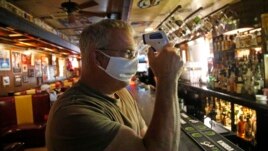08 June 2020
Businesses in the United States are opening up after closures ordered by health and other officials because of the coronavirus crisis. Many employers and employees are thinking about ways to reduce the risks of infection.
One common method to find out if people might be sick is the temperature check. It involves measuring a person's temperature as they enter a building.
Will temperature checks make the workplace safer?

Cheers to You bar owner Bob Brown tests a thermometer at his bar Friday, May 1, 2020, in Salt Lake City. Brown realize he needs to hire two or three new people just to enforce social distancing guidelines. (AP Photo/Rick Bowmer)
Checks can reduce the risk of COVID-19 infections. However, the Associated Press recently reported that they should not be the only safety measure that employers take.
Looking for fevers will not remove all of the risks. Even without a fever, people with the virus can still be contagious, or able to spread the virus to others.
Increased space, cleaning, and hand washing are also important, the AP noted.
Some employers are using infrared thermometers, devices that take temperature measurements from a distance. Workers could use the devices to take their own temperatures, if they use hand sanitizer before and after each use.
However, the thermometers might take incorrect measurements sometimes. The U.S. Food and Drug Administration (FDA) notes that some kinds of head coverings, like headbands or bandannas, can make a person too hot. Also, some kinds of face wipes can cool the skin.
The American Centers for Disease Control (CDC) describes temperature checks as an "optional strategy that employers may use."
The agency adds that other protective steps, such as "social distancing (maintaining a distance of about two meters from others), or physical barriers" may be more protective.
The FDA describes normal temperatures to be around 37 degrees Celsius. A statement on the FDA's website notes that "...some studies have shown that "normal" body temperature can be within a wide range, from 36.1°C to 37.2°C."
I'm John Russell.
John Russell adapted this story based on Associated Press reports and information from the CDC and FDA. Mario Ritter, Jr. was the editor.
________________________________________________________________
Words in This Story
fever – n. a body temperature that is higher than normal
contagious – adj. having a sickness that can be passed to someone else
sanitizer – n. a kind of cleaning product that makes something free from dirt, infection, disease, etc.
optional – adj. available as a choice but not required
strategy –n. a plan for reaching a goal that usually takes a long period of time
We want to hear from you. Write to us in the Comments Section.